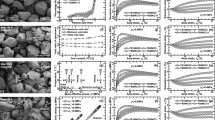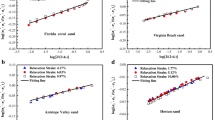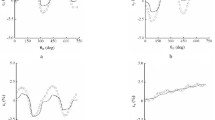Abstract
In the current study, we proposed a novel fractional-order thermo-mechanical constitutive model within the framework of critical state theory to depict the coupling effect of fine content and temperature on shear behaviors of sand–clay mixtures. The direction of the non-orthogonal plastic strain increment was derived by taking the fractional derivative of the yield surface without introducing an additional plastic potential function, which provided a unified description of the associated and non-associated flow rule. In addition, the fines- and temperature-dependent critical state was also considered. Subsequently, the performance of the fractional-order thermo-mechanical model was analyzed through parametric investigation. Comparisons between the predicted and experimental results demonstrate that the proposed model can effectively reproduce the strain-softening, dilatancy, and thermal softening behaviors of sand–clay mixtures with different confining pressures, fine contents, and temperatures.





Similar content being viewed by others
Data availability
Some or all data, models, or code generated or used during the study are available from the corresponding author by request.
References
Abuel-Naga HM, Bergado DT, Bouazza A (2007) Thermally induced volume change and excess pore water pressure of soft bangkok clay. Eng Geol 89:144–154. https://doi.org/10.1016/j.enggeo.2006.10.002
Abuel-Naga HM, Bergado DT, Bouazza A et al (2007) Volume change behaviour of saturated clays under drained heating conditions: experimental results and constitutive modeling. Can Geotech J 44:942–956. https://doi.org/10.1139/t07-03
Abuel-Naga HM, Pender M, Bergado DT et al (2009) Thermomechanical model for saturated clays. Géotechnique 59:273–278. https://doi.org/10.1680/geot.2009.59.3.273
Andersen O, Nilsen HM (2018) Investigating simplified modeling choices for numerical simulation of co2 storage with thermal effects. Int J Greenh Gas Control 72:49–64. https://doi.org/10.1016/j.ijggc.2018.03.011
Bai B, Zhou R, Cai G et al (2021) Coupled thermo-hydro-mechanical mechanism in view of the soil particle rearrangement of granular thermodynamics. Comput Geotech 137:104272. https://doi.org/10.1016/j.compgeo.2021.104272
Bardet JP (1986) Bounding surface plasticity model for sands. J Eng Mech 112:1198–1217. https://doi.org/10.1061/(ASCE)0733-9399(1986)112:11(1198)
Been K, Jefferies MG (1985) A state parameter for sands. Géotechnique 35:99–112. https://doi.org/10.1680/geot.1985.35.2.99
Bentil OT, Zhou C (2022) Effects of temperature and thermal cycles on the elastic shear modulus of saturated clay. J Geotech Geoenviron Eng 148:06022006. https://doi.org/10.1061/(ASCE)GT.1943-5606.0002822
Brandl H (2006) Energy foundations and other thermo-active ground structures. Géotechnique 56:81–122. https://doi.org/10.1680/geot.2006.56.2.81
Cai G, Han B, Zhou A et al (2022) Fractional-order bounding surface model for unsaturated soils under cyclic loading. Comput Geotech 141:104529. https://doi.org/10.1016/j.compgeo.2021.104529
Carraro JAH, Prezzi M, Salgado R (2009) Shear strength and stiffness of sands containing plastic or nonplastic fines. J Geotech Geoenviron Eng 135:1167–1178. https://doi.org/10.1061/(ASCE)1090-0241(2009)135:9(1167)
Cekerevac C, Laloui L (2004) Experimental study of thermal effects on the mechanical behaviour of a clay. Int J Numer Anal Methods Geomech 28:209–228. https://doi.org/10.1002/nag.332
Chang CS, Deng Y (2019) Revisiting the concept of inter-granular void ratio in view of particle packing theory. Géotech Lett 9:121–129. https://doi.org/10.1680/jgele.18.00175
Cheng W, Chen RP, Hong PY et al (2020) A two-surface thermomechanical plasticity model considering thermal cyclic behavior. Acta Geotech 15:2741–2755. https://doi.org/10.1007/s11440-020-00999-5
Coccia CJR, McCartney JS (2016) Thermal volume change of poorly draining soils ii: Model development and experimental validation. Comput Geotech 80:16–25. https://doi.org/10.1016/j.compgeo.2016.06.010
Collins IF, Kelly PA (2002) A thermomechanical analysis of a family of soil models. Géotech Lett 52:507–518. https://doi.org/10.1680/geot.2002.52.7.507
Cui YJ, Sultan N, Delage P (2000) A thermomechanical model for saturated clays. Can Geotech J 37:607–620. https://doi.org/10.1139/t99-111
Dalla SG, Cola S, Tateo F et al (2020) Hydraulic conductivity changes in compacted clayey barriers due to temperature variations in landfill top covers. Bull Eng Geol Env 79:2893–2905. https://doi.org/10.1007/s10064-020-01726-w
Delage P, Sultan N, Cui YJ (2000) On the thermal consolidation of boom clay. Can Geotech J 37:343–354. https://doi.org/10.1139/t99-105
Dong S, Li X, Tang AM et al (2019) Thermo-mechanical behavior of energy diaphragm wall: Physical and numerical modelling. Appl Therm Eng 146:243–251. https://doi.org/10.1016/j.applthermaleng.2018.09.054
Gawecka KA, Cui W, Taborda DMG et al (2021) Predictive modelling of thermo-active tunnels in london clay. Géotechnique 71:735–748. https://doi.org/10.1680/jgeot.19.P.376
Gens A, Sánchez M, Guimarães LDN et al (2009) A full-scale in situ heating test for high-level nuclear waste disposal: observations, analysis and interpretation. Géotechnique 59:377–399. https://doi.org/10.1680/geot.2009.59.4.377
Ghaaowd I, Takai A, Katsumi T et al (2017) Pore water pressure prediction for undrained heating of soils. Environ Geotech 4:70–78. https://doi.org/10.1680/jenge.15.00041
Ghahremannejad B (2003) Thermo-mechanical behaviour of two reconstituted clays. Thiesis, University of Sydney Civil Engineering, Ph.D
Gobbi S, Santisi d’Avila Maria P, Lenti L et al (2022) Effect of active plastic fine fraction on undrained behavior of binary granular mixtures. Int J Geomech 22:06021035. https://doi.org/10.1061/(ASCE)GM.1943-5622.0002242
Golchin A, Vardon PJ, Hicks MA (2022) A thermo-mechanical constitutive model for fine-grained soils based on thermodynamics. Int J Eng Sci 174:103579. https://doi.org/10.1016/j.ijengsci.2021.103579
Graham J, Tanaka N, Crilly T et al (2001) Modified cam-clay modelling of temperature effects in clays. Can Geotech J 38:608–621. https://doi.org/10.1139/t00-125
Guo PJ, Su XB (2007) Shear strength, interparticle locking, and dilatancy of granular materials. Can Geotech J 44:579–591. https://doi.org/10.1139/t07-010
Hamidi A, Tourchi S, Khazaei C (2015) Thermomechanical constitutive model for saturated clays based on critical state theory. Int J Geomech 15:04014038. https://doi.org/10.1061/(ASCE)GM.1943-5622.0000402
He SH, Shan HF, Xia TD et al (2021) The effect of temperature on the drained shear behavior of calcareous sand. Acta Geotech 16:613–633. https://doi.org/10.1007/s11440-020-01030-7
Hong PY, Pereira JM, Cui YJ et al (2016) A two-surface thermomechanical model for saturated clays. Int J Numer Anal Methods Geomech 40:1059–1080. https://doi.org/10.1002/nag.2474
Hong PY, Pereira JM, Tang AM et al (2013) On some advanced thermo-mechanical models for saturated clays. Int J Numer Anal Methods Geomech 37:2952–2971. https://doi.org/10.1002/nag.2170
Hueckel T, Baldi G (1990) Thermoplasticity of saturated clays: experimental constitutive study. J Geotech Eng 116:1778–1796. https://doi.org/10.1061/(ASCE)0733-9410(1990)116:12(1778)
Hueckel T, Borsetto M (1990) Thermoplasticity of saturated soils and shales: constitutive equations. J Geotech Eng 116:1765–1777. https://doi.org/10.1061/(ASCE)0733-9410(1990)116:12(1765)
Lahoori M, Rosin-Paumier S, Masrouri F (2021) Effect of monotonic and cyclic temperature variations on the mechanical behavior of a compacted soil. Eng Geol 290:106195. https://doi.org/10.1016/j.enggeo.2021.106195
Laloui L, Cekerevac C (2008) Numerical simulation of the non-isothermal mechanical behaviour of soils. Comput Geotech 35:729–745. https://doi.org/10.1016/j.compgeo.2007.11.007
Laloui L, Francois B (2009) Acmeg-t: Soil thermoplasticity model. J Eng Mech 135:932–944. https://doi.org/10.1061/(ASCE)EM.1943-7889.0000011
Lashkari A (2016) Prediction of flow liquefaction instability of clean and silty sands. Acta Geotech 11:987–1014. https://doi.org/10.1007/s11440-015-0413-9
Lashkari A (2014) Recommendations for extension and re-calibration of an existing sand constitutive model taking into account varying non-plastic fines content. Soil Dyn Earthq Eng 61–62:212–238. https://doi.org/10.1016/j.soildyn.2014.02.012
Li H, Kong G, Wen L et al (2021) Pore pressure and strength behaviors of reconstituted marine sediments involving thermal effects. Int J Geomech 21:06021008. https://doi.org/10.1061/(ASCE)GM.1943-5622.0001984
Li XS, Dafalias YF (2000) Dilatancy for cohesionless soils. Géotechnique 50:449–460. https://doi.org/10.1680/geot.2000.50.4.449
Liang JY, Lu DC, Zhou X et al (2019) Non-orthogonal elastoplastic constitutive model with the critical state for clay. Comput Geotech 116:103200. https://doi.org/10.1016/j.compgeo.2019.103200
Liu EL, Xing HL (2008) A double hardening thermo-mechanical constitutive model for overconsolidated clays. Acta Geotech 4:1–6. https://doi.org/10.1007/s11440-008-0053-4
Liu H, Liu H, Xiao Y et al (2018) Effects of temperature on the shear strength of saturated sand. Soils Found 58:1326–1338. https://doi.org/10.1016/j.sandf.2018.07.010
Liu Y, Cai G, Zhou A et al (2021) A fully coupled constitutive model for thermo-hydro-mechanical behaviour of unsaturated soils. Comput Geotech 133:104032. https://doi.org/10.1016/j.compgeo.2021.104032
Lu D, Zhou X, Du X et al (2019) A 3d fractional elastoplastic constitutive model for concrete material. Int J Solids Struct 165:160–175. https://doi.org/10.1016/j.ijsolstr.2019.02.004
Lu DC, Liang JY, Du XL et al (2019) Fractional elastoplastic constitutive model for soils based on a novel 3d fractional plastic flow rule. Comput Geotech 105:277–290. https://doi.org/10.1016/j.compgeo.2018.10.004
Lu DC, Meng FP, Zhou X et al (2022) Double scalar variables plastic-damage model for concrete. J Eng Mech 148:04021143. https://doi.org/10.1061/(ASCE)EM.1943-7889.0002050
Mašín D, Khalili N (2012) A thermo-mechanical model for variably saturated soils based on hypoplasticity. Int J Numer Anal Methods Geomech 36:1461–1485. https://doi.org/10.1002/nag.1058
McDowell GR (2002) A simple non-associated flow model for sand. Granul Matter 4:65–69. https://doi.org/10.1007/s10035-002-0106-6
Ng CWW, Wang SH, Zhou C (2016) Volume change behaviour of saturated sand under thermal cycles. Géotech Lett 6:124–131. https://doi.org/10.1680/jgele.15.00148
Ochsner K (2008) Carbon dioxide heat pipe in conjunction with a ground source heat pump (gshp). Appl Therm Eng 28:2077–2082. https://doi.org/10.1016/j.applthermaleng.2008.04.023
Porcino DD, Diano V, Triantafyllidis T et al (2020) Predicting undrained static response of sand with non-plastic fines in terms of equivalent granular state parameter. Acta Geotech 15:867–882. https://doi.org/10.1007/s11440-019-00770-5
Rahman MM, Lo SR, Baki MAL (2011) Equivalent granular state parameter and undrained behaviour of sand-fines mixtures. Acta Geotech 6:183–194. https://doi.org/10.1007/s11440-011-0145-4
Rahman MM, Lo SR, Dafalias YF (2014) Modelling the static liquefaction of sand with low-plasticity fines. Géotechnique 64:881–894. https://doi.org/10.1680/geot.14.P.079
Roberto DLV, Fontana L, Vallati A (2014) Experimental study of thermal field deriving from an underground electrical power cable buried in non-homogeneous soils. Appl Therm Eng 62:390–397. https://doi.org/10.1016/j.applthermaleng.2013.09.002
Sun Y, Shen Y (2017) Constitutive model of granular soils using fractional-order plastic-flow rule. Int J Geomech 17:04017025. https://doi.org/10.1061/(ASCE)GM.1943-5622.0000904
Sun Y, Sumelka W, Gao Y et al (2021) Phenomenological fractional stress–dilatancy model for granular soil and soil-structure interface under monotonic and cyclic loads. Acta Geotech 16:3115–3132. https://doi.org/10.1007/s11440-021-01190-0
Sun Y, Xiao Y (2017) Fractional order plasticity model for granular soils subjected to monotonic triaxial compression. Int J Solids Struct 118:224–234. https://doi.org/10.1016/j.ijsolstr.2017.03.005
Sun ZC (2022) Mechanical properties and constitutive model of sand-clay mixtures considering temperature effect. School of Civil Engineering, Chongqing University; PhD Thesis.
Sun ZC, Chu J, Xiao Y (2021) Formulation and implementation of an elastoplastic constitutive model for sand-fines mixtures. Int J Numer Anal Methods Geomech 45:2682–2708. https://doi.org/10.1002/nag.3282
Sun ZC, Xiao Y, Meng M et al (2023) Thermally induced volume change behavior of sand–clay mixtures. Acta Geotech 18:2373–2388. https://doi.org/10.1007/s11440-022-01744-w
Thevanayagam S, Shenthan T, Mohan S et al (2002) Undrained fragility of clean sands, silty sands, and sandy silts. J Geotech Geoenviron Eng 128:849–859. https://doi.org/10.1061/(ASCE)1090-0241(2002)128:10(849)
Uchaipichat A, Khalili N (2009) Experimental investigation of thermo-hydro-mechanical behaviour of an unsaturated silt. Géotechnique 59:339–353. https://doi.org/10.1680/geot.2009.59.4.339
Wang LZ, Wang KJ, Hong Y (2016) Modeling temperature-dependent behavior of soft clay. J Eng Mech 142:04016054. https://doi.org/10.1061/(ASCE)EM.1943-7889.0001108
Wei X, Yang J (2023) Characterising the effect of particle size disparity on liquefaction resistance of non-plastic silty sands from a critical state perspective. Géotechnique 73:323–336. https://doi.org/10.1680/jgeot.21.00145
Xiao Y, Chen H, Stuedlein AW et al (2020) Restraint of particle breakage by biotreatment method. J Geotech Geoenviron Eng 146:04020123. https://doi.org/10.1061/(ASCE)GT.1943-5606.0002384
Xiao Y, Fang QY, Liu S et al (2023) Morphology and fines type effect on packing of binary soils. Transp Geotech 42:101043. https://doi.org/10.1016/j.trgeo.2023.101043
Xiao Y, Jiang X, Liu H et al (2017) Strength-dilatancy relation of sand containing non-plastic fines. Géotech Lett 7:204–210. https://doi.org/10.1680/jgele.16.00144
Xiao Y, Li H, Shi J et al (2023) Effect of particle size on small strain stiffness of biotreated sands. Transp Geotech 41:101027. https://doi.org/10.1016/j.trgeo.2023.101027
Xiao Y, Liu H, Chen Y et al (2014) Bounding surface model for rockfill materials dependent on density and pressure under triaxial stress conditions. J Eng Mech 140:04014002. https://doi.org/10.1061/(ASCE)EM.1943-7889.0000702
Xiao Y, Zhang X, Wang C et al (2023) Breakage-dependent fractional plasticity model for sands. Int J Geomech 23:04022299. https://doi.org/10.1061/IJGNAI.GMENG-8140
Xiao Y, Zhang Z, Stuedlein AW et al (2021) Liquefaction modeling for biocemented calcareous sand. J Geotech Geoenviron Eng 147:04021149. https://doi.org/10.1061/(ASCE)GT.1943-5606.0002666
Xiong YL, Yang QL, Sang QY et al (2019) A unified thermal-hardening and thermal-softening constitutive model of soils. Appl Math Model 74:73–84. https://doi.org/10.1016/j.apm.2019.04.034
Xiong YL, Yang QL, Zhang S et al (2018) Thermo-elastoplastic model for soft rock considering effects of structure and overconsolidation. Rock Mech Rock Eng 51:3771–3784. https://doi.org/10.1007/s00603-018-1557-3
Xu L-Y, Zhang J-Z, Cai F et al (2019) Constitutive modeling the undrained behaviors of sands with non-plastic fines under monotonic and cyclic loading. Soil Dyn Earthq Eng 123:413–424. https://doi.org/10.1016/j.soildyn.2019.05.021
Yang G, Liu Y, Chen P (2022) Thermal consolidation of saturated silty clay considering different temperature paths: experimental study and constitutive modeling. Int J Geomech 22:04021293. https://doi.org/10.1061/(ASCE)GM.1943-5622.0002294
Yang J, Wei LM (2012) Collapse of loose sand with the addition of fines: the role of particle shape. Géotechnique 62:1111–1125. https://doi.org/10.1680/geot.11.P.062
Yang J, Wei LM, Dai BB (2015) State variables for silty sands: global void ratio or skeleton void ratio? Soils Found 55:99–111. https://doi.org/10.1016/j.sandf.2014.12.008
Yao Y, He G, Luo T (2023) Study on determining the plastic flow direction of soils with dilatancy. Acta Geotech 18:2411–2425. https://doi.org/10.1007/s11440-022-01770-8
Yao YP, Zhou AN (2013) Non-isothermal unified hardening model: a thermo-elastoplastic model for clays. Géotechnique 63:1328–1345. https://doi.org/10.1680/geot.13.P.035
Ye WM, Zhang YW, Chen B et al (2012) Investigation on compression behaviour of highly compacted gmz01 bentonite with suction and temperature control. Nucl Eng Des 252:11–18. https://doi.org/10.1016/j.nucengdes.2012.06.037
Yeşiller N, Hanson JL, Oettle NK et al (2008) Thermal analysis of cover systems in municipal solid waste landfills. J Geotech Geoenviron Eng 134:1655–1664. https://doi.org/10.1061/(ASCE)1090-0241(2008)134:11(1655)
Yilmaz Y, Deng Y, Chang CS et al (2023) Strength-dilatancy and critical state behaviours of binary mixtures of graded sands influenced by particle size ratio and fines content. Géotechnique 73:202–217. https://doi.org/10.1680/jgeot.20.P.320
Yin D, Wu H, Cheng C et al (2013) Fractional order constitutive model of geomaterials under the condition of triaxial test. Int J Numer Anal Methods Geomech 37:961–972. https://doi.org/10.1002/nag.2139
Zhang S, Leng WM, Zhang F et al (2012) A simple thermo-elastoplastic model for geomaterials. Int J Plast 34:93–113. https://doi.org/10.1016/j.ijplas.2012.01.011
Zhang ZC, Cheng XH (2016) A thermo-mechanical coupled constitutive model for clay based on extended granular solid hydrodynamics. Comput Geotech 80:373–382. https://doi.org/10.1016/j.compgeo.2016.05.010
Zhou C, Ng CWW (2015) A thermomechanical model for saturated soil at small and large strains. Can Geotech J 52:1101–1110. https://doi.org/10.1139/cgj-2014-0229
Zhu Q-Y, Zhuang P-Z, Yin Z-Y et al (2021) State parameter-based thermomechanical constitutive model for fine-grained saturated soils. Can Geotech J 58:1045–1058. https://doi.org/10.1139/cgj-2019-0322
Acknowledgements
The authors would like to acknowledge the financial support of the National Nature Science Foundation of China (Grant Nos. 52078085 and 51922024).
Author information
Authors and Affiliations
Corresponding author
Ethics declarations
Conflict of interest
The authors declare that they have no known competing financial interests or personal relationships that could have appeared to influence the work reported in this paper.
Additional information
Publisher's Note
Springer Nature remains neutral with regard to jurisdictional claims in published maps and institutional affiliations.
Rights and permissions
Springer Nature or its licensor (e.g. a society or other partner) holds exclusive rights to this article under a publishing agreement with the author(s) or other rightsholder(s); author self-archiving of the accepted manuscript version of this article is solely governed by the terms of such publishing agreement and applicable law.
About this article
Cite this article
Xiao, Y., Sun, Z., Wang, N. et al. Thermo-mechanical behavior of sand–clay mixtures—Part II: constitutive modeling. Acta Geotech. (2023). https://doi.org/10.1007/s11440-023-02125-7
Received:
Accepted:
Published:
DOI: https://doi.org/10.1007/s11440-023-02125-7




